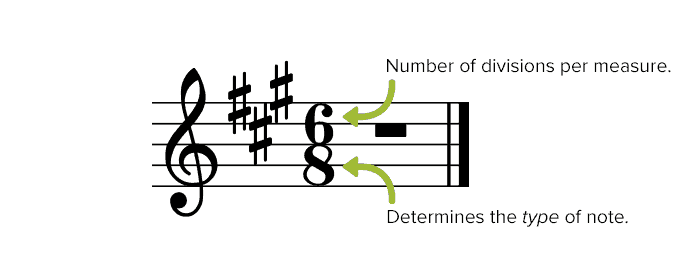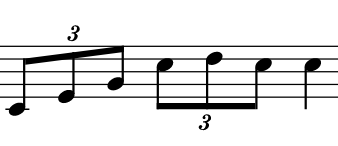1.6 Simple and Compound Beat Division
7 min read•june 18, 2024
Mickey Hansen
AP Music Theory 🎶
72 resourcesSee Units
Simple and Compound Meters
In music theory, meter refers to the rhythmic structure of a piece of music, or the pattern of strong and weak beats within a measure. Usually, we notice that there are many different ways you hear the pulses of music, or the "beat" of a piece. The largest structure (arguably) is the measure. Try listening to one of Chopin's waltzes. You might hear each measure as one "beat," with one strong downbeat and two weaker beats within that.
All the beats inside the measure are considered the beat, and it's another way to count the pulses in music. The number of beats in a measure depends on the time signature and the type of meter (simple vs. compound).
Simple meters are meters where most of the beats are divided into twos. A good heuristic is that if the bottom number on the time signature is 4, then it will be a simple meter. For simple meters, the top number of the time signature tells you how many beats there are per measure. For example, a time signature of 4/4 indicates that there are four beats per measure, and a quarter note receives one beat. A time signature of 3/4 indicates that there are three beats per measure, and a quarter note receives one beat.
Compound meters, on the other hand, are meters where beats mostly divide into threes. If you've ever played music in 6/8 time, you might notice that there are supposed to be 6 "beats" per measure according to the time signature, but really, it sounds like two big beats per measure, where each beat is divided up into three smaller beats. This is an example of compound meter.

Image via MusicNotes
Other examples are 9/8 time and 12/8 time. If you encounter a time signature where the bottom number is 8, it is probably a compound meter. However, this is again just a heuristic -- not a musical rule. For example, 3/8 time is a simple meter. This is because we need to identify three "layers" of the meter. If we think that 3/8 time is a compound meter, then the measure and beat are the same, which is no good.
In complex meters, the number of beats per measure is the top number of the time signature divided by 3. There are 2 beats in 6/8 time, 3 beats in 9/8 time, and so on. Each of the smaller beats are considered beat divisions. You will feel 6 beat divisions in 6/8 time, for example.
Simple meters can create a sense of stability and predictability, and they are often used in music that is meant to be danced to or that has a strong, driving beat. They are also commonly used in popular music, folk music, and other forms of music that have a strong sense of groove or pulse. Compound meters, on the other hand, can create a more complex, syncopated feel, and they are often used in music that has a more intricate or irregular rhythm.
The meter of a piece of music can have a significant impact on its overall feel and groove. Different meters can create different moods or sensations, and they can also affect how the music is played and how it sounds. In addition to the time signature, the meter of a piece of music can also be influenced by other rhythmic elements such as the tempo, or the speed at which the music is played, and the placement of accents, or emphasis on certain beats.
If you're unsure about the meter when you're hearing a piece, remember that meter is hierarchical: you can listen to the tempo to give you clues about the meter. Faster tempos, for example, probably have a faster meter, and it is likely that you are hearing beat divisions rather than actual beats.
Consider this very famous piece by Debussy. You will hear groups of three notes, which might cause you to think that the tempo is in 3/4. But, first, notice that on a broader level, there are three groups of three notes each that have strong and weaker beats. Next, notice that if you count the tempo of each of the groups of three notes, the tempo would be crazy fast! From this, we surmise that each group of three is just one beat, and the time signature is 9/8.
Rhythm vs. Beat Division
Notice that even if a piece is written in simple meter, there can still be beats that are subdivided into three, five, seven, etc. We saw this in Unit 1.2, where we learned about triplets. As a quick recap, a triplet is a musical notation that indicates that three notes are to be played in the time normally occupied by two notes of the same duration. In other words, each note in a triplet is played with a duration that is two-thirds of its normal value.
Triplets are often indicated by a "3" written above or below the group of notes that are to be played as a triplet. For example, if a group of quarter notes is written as a triplet, each note would be played with a duration of one-and-a-half beats, rather than two beats. Here's what a triplet looks like:

There are also quarter note triplets, which divide the length of two quarter notes into three sections. In the case of quarter note triplets, there will be a bracket above or below the notes to indicate that there should be three notes in the space of two beats.

Triplets can be written in any meter, and they can be used to create complex or syncopated rhythms. They are often used in jazz, blues, and other forms of music that have a more irregular or syncopated beat.
In addition to triplets, there are also other types of note values that can be written as groups of three notes, such as quintuplets (five notes in the time normally occupied by four) and septuplets (seven notes in the time normally occupied by four). These types of groupings are less common than triplets, but they can be used to create even more complex rhythms and time divisions.
The main idea to remember here is that the meter tells you the big picture. If most beats are divided up into twos but there are a few triplets here and there, then you are still in a simple meter. You should usually be able to feel the meter as consistent pulses or beats. There might be a few blips or changes in the meter during the piece, but go with the meter that you are feeling for the majority of the piece, and try not to overthink it!
Examples
Pieces in Simple Meters
Here are a few examples of piano pieces written in simple meters:
- "Twinkle, Twinkle, Little Star" is a children's song written in the time signature of 4/4. The song has a steady, straightforward beat, and it is often used as a teaching tool to help young musicians learn to count and keep a steady pulse.
- "The Entertainer" is a ragtime piano piece written by Scott Joplin in the time signature of 2/4. The piece has a lively, upbeat feel, and it is known for its catchy melody and strong sense of groove.
- "Moon River" is a popular song written by Henry Mancini in the time signature of 3/4. The piece has a slower, more contemplative feel, and it is often played as a solo piano piece.
- "Maple Leaf Rag" is a ragtime piano piece written by Scott Joplin in the time signature of 4/4. The piece has a lively, upbeat feel, and it is known for its catchy melodies and strong sense of groove.
I included some pieces in ragtime to show that simple meters are not always "simple." Ragtime music is a style of piano music that typically has a fast tempo and a strong sense of groove. It is characterized by its use of syncopated rhythms, which place the accent on the off-beats rather than the downbeats. The left hand of the piano typically plays a steady, repetitive bass pattern, while the right hand plays a more syncopated melody.
You probably won't be asked to figure out the time signatures of pieces in ragtime for the AP Music exam, but can you still feel the measures and the beats? Try clapping along.
🦜 Polly wants a progress check! Listen to Haydn's Cello Concerto in D Major. What time signature do you think there is?
Pieces in Compound Meters
Compound meters can create a more complex, syncopated feel, and they are often used in music that has a more intricate or irregular rhythm. Here are a few examples of music written in compound meter:
- "Linus and Lucy" is a jazz piano piece written by Vince Guaraldi in the time signature of 6/8. The piece has a lively, swinging feel, and it is often used as the theme music for the Peanuts television specials.
- Symphony No. 5 in C minor, Op. 67 by Ludwig van Beethoven is a symphony written in the time signature of 3/4. While the time signature of 3/4 is typically associated with simple meters, some theorists argue that it is still a compound meter. Beethoven uses the triplet figure extensively, dividing each beat into three smaller units and creating a more complex, syncopated feel. The first movement of the symphony, in particular, is known for its iconic opening theme, which features a series of triplet figures played by the strings. The use of triplets in the first movement helps to create a sense of tension and forward momentum, and it is an important element of the movement's overall structure and form.
Take a moment to think about the second example. Listen to the piece on YouTube. Do you notice a simple meter or a compound one? Music theory isn't always as clear cut as it seems! You can decide for yourself which type of meter you think is used, and as long as you have a decent argument to support your analysis, you are probably right.
Browse Study Guides By Unit
🎵Unit 1 – Music Fundamentals I (Pitch, Major Scales and Key Signatures, Rhythm, Meter, and Expressive Elements)
🎶Unit 2 – Music Fundamentals II (Minor Scales and Key Signatures, Melody, Timbre, and Texture)
🎻Unit 3 – Music Fundamentals III (Triads and Seventh Chords)
🎹Unit 4 – Harmony and Voice Leading I (Chord Function, Cadence, and Phrase)
🎸Unit 5: Harmony and Voice Leading II: Chord Progressions and Predominant Function
🎺Unit 6 – Harmony and Voice Leading III (Embellishments, Motives, and Melodic Devices)
🎤Unit 7 – Harmony and Voice Leading IV (Secondary Function)
🎷Unit 8 – Modes & Form
🧐Exam Skills
📚Study Tools

Fiveable
Resources
© 2025 Fiveable Inc. All rights reserved.